


Experiments with magnets and our surroundings
What is a magnetic field?
A magnet produces a vector field, the magnetic field, at all points in the space around it. It can be defined by measuring the force the field exerts on a moving charged particle, such as an electron. The force (F) is equal to the charge (q) times the speed of the particle times the magnitude of the field (B), or F = q*v x B, where the direction of F is at right angles to both v and B as a result of the cross product. This defines the magnetic field's strength and direction at any point.
What creates the magnetic field?
A magnetic field can be created with moving charges, such as a current-carrying wire. A magnetic field can also be created by the spin magnetic dipole moment, and by the orbital magnetic dipole moment of an electron within an atom.
What is the relationship between current flow and magnetic fields?
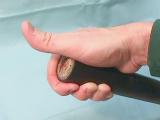
This is the Right Hand Rule for magnetic field from flowing current, and for magnetic field in a coil.
When current flows in a wire, a magnetic field is created around the wire. To visualize this, take your right hand, curl the fingers, and stick the thumb straight out. Now, point your thumb in the direction of the current flowing in the wire (using conventional current where current flows from the + end of a battery to the - end of the battery. NOTE: electrons flow from the - end of a battery to the + end, and is called electron current instead of conventional current). The direction your fingers are curved around the wire is the direction of the magnetic field around the wire. For example, if the current were coming straight out of this page toward you, your thumb would be pointing toward you and your fingers would indicate a counter-clockwise direction to the magnetic field around the wire.

This shows the magnetic field around a wire carrying current.
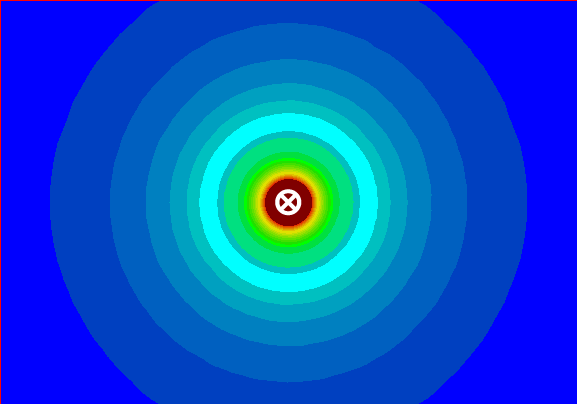
This shows the strength of the magnetic field around the wire. It is stronger the closer you are to the wire. The x inside the wire indicates that the current is flowing into the wire, away from you.
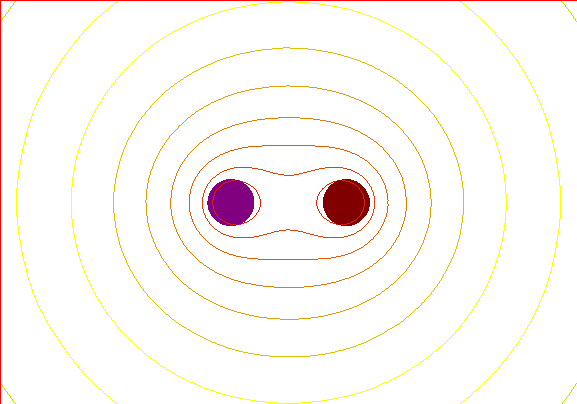
This shows the field around two wires, side by side, that are carrying current in the same direction. The wires are attracted to each other, and will pull themselves closer together.
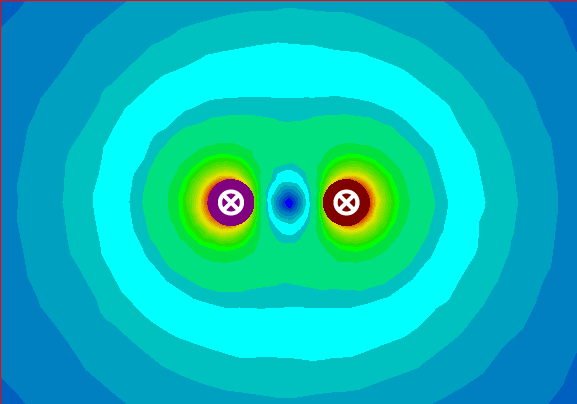
This shows the magnetic field strength around the two wires. Current is flowing into both wires. Notice how the magnetic field is slightly stronger on the side of the wire away from the other wire? This is showing that the magnetic field around a wire affects how the current flows in neighboring wires.

This shows the field around two wires, side by side, that are carrying current in opposite directions. The wires are repelling each other, and will push themselves further apart.
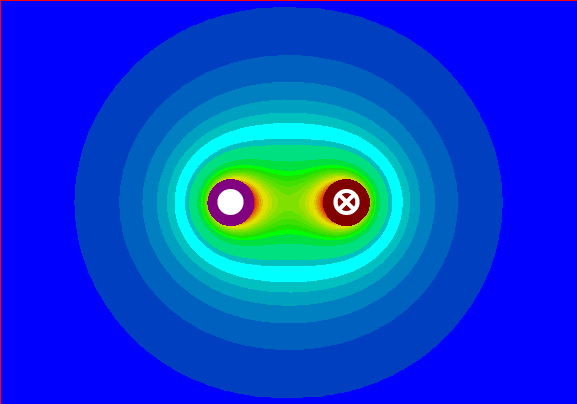
This shows the magnetic field strength around the two wires. Current is flowing into the wire on the right, and out of the wire on the left. Notice how the magnetic field is slightly stronger on the side of the wire facing the other wire? This is showing that the magnetic field around a wire affects how the current flows in neighboring wires.
If you have a coil of wire, simply curve the fingers of your right hand around the coil in the same direction as the current is flowing. Your thumb will point out of the north magnetic pole which the coil of wire will create.
By convention, we state that the magnetic field has a direction associated with it, such that the field exits the North end of a magnet, flows through the air or other materials nearby, and re-enters the South end of the magnet. Inside the magnet, the field flows from the South back to the North.
In summary, current flows from + to - of a battery, and magnetic fields flow from the North to the South of a magnet.
What do we know about magnetic field lines?
Magnetic field lines are a way to visualize the magnetic field. When drawn, the distance between them is an indication of the strength of the field. The closer they are, the stronger the field. For example, the number of lines per square centimeter is a measure of the strength of the magnetic field. Specifically, 1 Gauss is equivalent to 1 magnetic field line within 1 square centimeter. Also, the direction of the tangent to the field line is the direction of the magnetic field at that point and is the direction a compass would point..
What are magnetic fields made of?
A tremendous amount of research has gone into the area of elementary particle physics - the study of the basic building blocks of all the matter we know of. We used to think that electrons, protons, neutrons and photons were all there was. However, we then discovered a host of other particles which make up the protons and neutrons. Today, we know of 12 particles and 4 electroweak forces and 1 strong force. They are:
| Fermions (matter carriers) | Bosons (force carriers) | ||
| Leptons | Quarks | Unified Electroweak | Strong |
| electron neutrino | up | photon | gluon |
| electron | down | W- | |
| muon neutrino | charm | W+ | |
| muon | strange | Zo | |
| tau neutrino | top | ||
| tau | bottom | ||
So, how does one magnet feel the presence of another magnet when they approach each other? I don't think physicists really know the answer to that. They know that the electromagnetic field is actually made of an enormous number of photons, but do virtual, massless photons make up the magnetic field, and how does one field affect other magnetic fields at a distance, and does the magnetic field travel at the speed of light like gravitational waves? Perhaps you will be the one to discover some of these answers.
Two excellent books on how we got from
electrons, protons, neutrons and photons to all of the above are:
"Interactions," Sheldon Glashow, Warner Books,
1988, ISBN 0-446-38946-3
"The Elegant Universe," Brian Greene, Vintage
Books, 1999, ISBN 0-375-70811-1